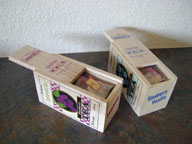 |
Tea Boxes |
 |
 |
Tea Boxes |
 |
Students work in pairs or in small groups. Each pair needs one wooden box in which Fortunes Commonwealth Teas are sold, a ruler, and a calculator. (We found the tea boxes, which contain 20 tea bags, for $1.99 each at Ross Stores.) The boxes are very light. They are made from balsa wood. (The discussion of balsa wood is an interesting topic. It is one of the lightest woods in the world. It grows in South America and is sold mainly in hobby shops. It was used to build the raft Kon-Tiki, which was used by the explorer Thor Heyerdal. “Balsa” in Spanish means raft or boat.) A map showing Sri Lanka (formerly Ceylon) can also be shown. (See the URL below.)
![]() Tools:
Ruler, calculator
Tools:
Ruler, calculator
Task.
Compute the volume of the whole box, and the volume of its interior.
Part one.
All students, without making any measurements, estimate what percentage of the
total volume the volume of the interior of the box makes up. Their estimates
are recorded, and at the end the best estimate is announced. (When we did this
unit in a university class, the guesses ranged from 75 to 95%.)
Part two.
Measurements are made and recorded. Both volumes are computed. (The results
have to be appropriately rounded.)
Solution for the box we measured.
Exterior length = 13.9 cm. |
||
Exterior height = 7.6 cm. |
||
Exterior width = 6.4 cm. |
||
Interior length = 12.6 cm. |
||
Interior height = 6.3 cm. |
||
Interior width = 4.8 cm. |
The external dimensions are 13.9 cm, 7.6 cm, and 6.4 cm.
The internal dimensions are 12.6 cm, 6.3 cm, and 4.8 cm.
The total volume of the box is 676 cu. cm.
The volume of the interior is 381 cu. cm.
The volume of the interior is 56% of the total volume!
Location of Sri Lanka

A close-up map of Sri Lanka can be found at:
https://www.worldatlas.com/webimage/countrys/asia/lk.htm
Information about balsa wood can be found at: http://www.mat.uc.pt/~pedro/ncientificos/artigos/techbal.html